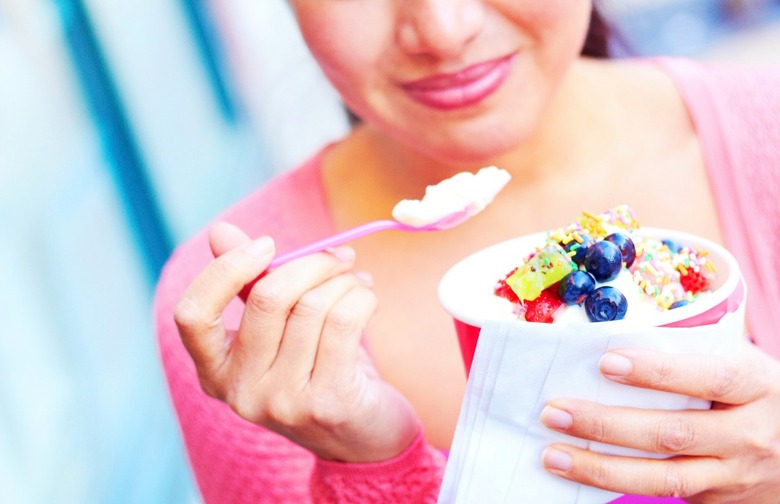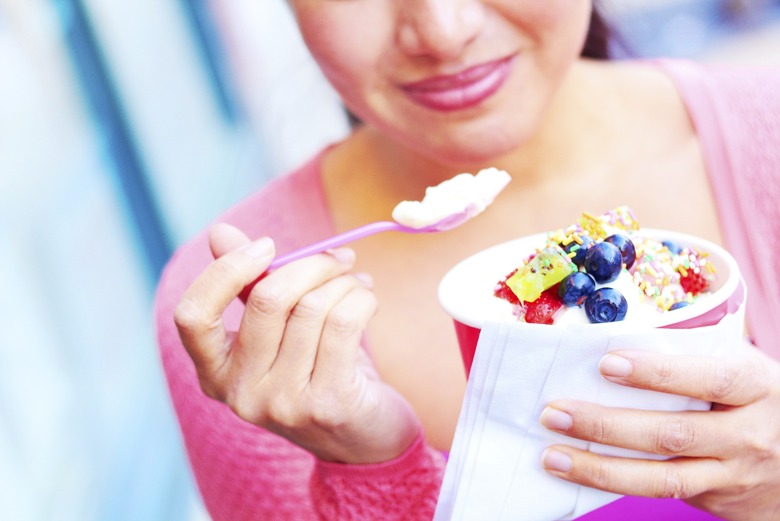10 Reasons Dietitians Won't Eat Frozen Yogurt
10 Reasons Dietitians Won’t Eat Frozen Yogurt
If you've ever been to one of the 25 Best Frozen Yogurt Shops Across the U.S., you'll be familiar with the following scene: a seemingly endless supply of handles protrude from brightly colored walls, each labeled with some tantalizing flavor of sweet self-serve goodness. Past the yogurt dispensers, an endless field of bright, sugar-coated toppings awaits harvesting. No, this isn't Willy Wonka's chocolate factory; this is a real-life chain froyo shop.
Frozen yogurt chains have made heaping piles of money by promoting their products as being healthier than ice cream, but we're not so sure that such proclamations are accurate. While some frozen yogurt flavors certainly do have fewer calories than ice cream, not all of them are created equal. Frozen yogurt is just one of many foods that pretend to be healthy.
Beyond the actual yogurt, once you get to that unhealthy, salad bar-style toppings spread, it's easy to add a bunch of sugar-laden candies that stand in stark opposition to proper nutrition. We've reached out to some dietary experts in order to hear their thoughts on frozen yogurt.
Artificial Ingredients
"Frozen yogurt typically contains artificial flavors and artificial colors, as well as other additives," says Rebecca Lewis, in-house RD at HelloFresh. "While there is much debate about the health consequences of consuming these types of ingredients, what can be said is that they are an indicator of a processed food and about as far from nature as possible."
Examples of Artificial Ingredients
"There are additives like guar gum, maltodextrin, sodium citrate, cellulose gum, disodium phosphate, and propylene glycol monoesters to name just a few don't-sound-like-food ingredients," says Dr. Rob Silverman, certified nutrition specialist.
Click here for Humectants, Tracer Gas, and 9 Other Scary-Sounding Additives in Your Food.
"Some [frozen yogurt] contains carrageenan, a thickening agent derived from red seaweed that has been associated with adverse health effects."
It May Not Contain as Many Probiotics as We Think
Dr. Rob Silverman, certified nutrition specialist, says that frozen yogurt may not contain as many probiotics as we think. He warns that "extreme temperatures like the freezing process kill yogurt's probiotics."
Click here for 5 Probiotic-Packed Healthy Recipes.
Dr. Silverman suggests looking "for the 'Live and Active Cultures' seal" when choosing frozen yogurt.
Less Fat Isn’t Always Healthier
"Frozen yogurt is usually lower in fat because milk is used instead of cream," says Rebecca Lewis, in-house RD at HelloFresh. "While initially this may seem like a good thing, as a consequence, frozen yogurt is often higher in sugar. Some [types of] frozen yogurt can range upward of 20-30 grams of sugar in just a four-ounce [or one-half cup] serving. And let's be honest, very few of us eat such a small amount. Truthfully, with sugar recommendations as no more than 12 teaspoons per day (or 48 grams), a cup of frozen yogurt may end up [containing] all the sugar you should consume all day!"
Less Fat Isn’t Always True
In YouBeauty's 5 Foods Nutritionists Won't Eat, Kristin Kirkpatrick, MS, RD, LD, says that "even frozen yogurt can be loaded with fat and... [is] high in calories, especially when you add on toppings that range from candy to hot fudge." Taking a glance at any of these 25 Over-the-Top Fudge Recipes will show you that, while they may sound delicious, they're certainly not part of any healthy eating template. Depending on the toppings you choose to add, the final product may wind up having an incredibly high fat content.
Low-Fat Doesn’t Mean Low in Calories
A lack of proper portion control can lead to excess calorie consumption. "Most people would pick a cup that contains four servings rather than just one," says Dr. Rob Silverman, certified nutrition specialist. "A healthier treat would be to choose a kiddie cup instead. We perceive 'yogurt' to be healthy, therefore [justifying] a bigger portion [which] could run anywhere from 300 to 400 calories before you add any toppings."
Try faking frozen yogurt with this recipe in order to make it a lower calorie treat.
More Sugar Than Ice Cream
While frozen yogurt is advertised as the healthier option, you may be better off going to one of the 10 Best Ice Cream Parlors in America if you want less sugar. "Per each half-cup serving, frozen yogurt contains roughly 17 grams of sugar," says Dr. Rob Silverman, certified nutrition specialist. "Meanwhile, ice cream only has about 14 grams of the sweet stuff for the same serving size." If you eat a normal-sized, misguided portion of froyo, you may undergo one of these 6 Signs Your Body Has Had Too Much Sugar.
Nasty Sugar Substitutes
While some artificial sweeteners don't taste awful, Dr. Rob Silverman still warns against the synthetic sugars that are often added to frozen yogurt. He says that "many froyo brands also add sugar substitutes that could cause digestive issues like bloating or cramping;" just more proof that sugar-free and low-calorie foods are ruining your diet.
The Self-Serve Dilemma
"What's more, some of these frozen yogurt establishments let you serve — or shall we say over-serve — yourself, throwing portion control out the window, says Kristin Kirkpatrick, MS, RD, LD. She cites a study in the American Journal of Preventative Medicine, which "showed that the size of the bowl and even the spoon influence how much food people serve and eat. The study participants were actually nutrition experts who, despite their expertise, unknowingly served themselves 31 percent more when given a large bowl and 14.5 percent more when wielding a large serving spoon."
Toppings Are Almost Certainly Diet-Killers
Dr. Rob Silverman, certified nutrition specialist, warns against going overboard at the toppings buffet and choosing too many unhealthy options. The toppings provided at many frozen yogurt establishments include the same candies that children eat on Easter and even the unhealthiest Halloween treats. He suggests healthy toppings such as fresh fruits, a spoonful of crushed nuts, or a spoonful of dark chocolate shavings for more nutritious texture and a little crunch.











